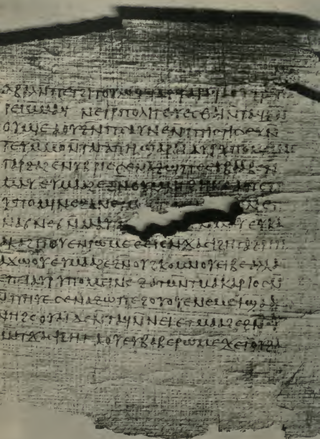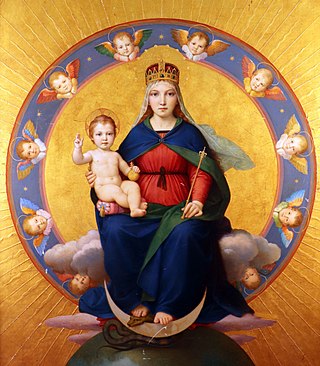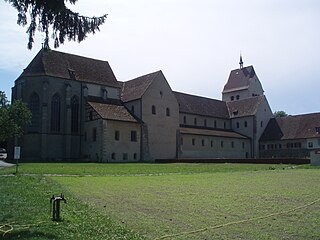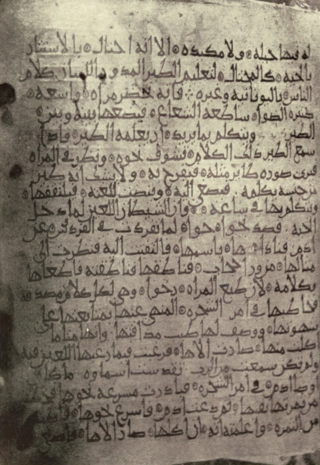The Apostles' Creed, sometimes titled the Apostolic Creed or the Symbol of the Apostles, is a Christian creed or "symbol of faith".
The New Testament (NT) is the second division of the Christian biblical canon. It discusses the teachings and person of Jesus, as well as events relating to first-century Christianity. The New Testament's background, the first division of the Christian Bible, is called the Old Testament, which is based primarily upon the Hebrew Bible; together they are regarded as Sacred Scripture by Christians.

The Dormition of the Mother of God is a Great Feast of the Eastern Orthodox, Oriental Orthodox, and Eastern Catholic Churches. It celebrates the "falling asleep" (death) of Mary the Theotokos, and her being taken up into heaven. The Feast of the Dormition is observed on August 15, which for the churches using the Julian calendar corresponds to August 28 on the Gregorian calendar. The Armenian Apostolic Church celebrates the Dormition not on a fixed date, but on the Sunday nearest 15 August. In Western Churches the corresponding feast is known as the Assumption of Mary, with the exception of the Scottish Episcopal Church, which has traditionally celebrated the Falling Asleep of the Blessed Virgin Mary on August 15.

The Apocalypse of Peter, also called the Revelation of Peter, is an early Christian text of the 2nd century and a work of apocalyptic literature. It is not included in the standard canon of the New Testament, but is classed as part of New Testament apocrypha. The Apocalypse of Peter is mentioned in the Muratorian fragment, a 2nd-century list of books thought to be canonical in Christianity. The Muratorian fragment expresses some hesitation on the work, saying that some authorities would not have it read in church. The text is extant in two incomplete versions based on a lost Koine Greek original: an edited Greek version and an Ethiopic version, which diverge considerably. It is influenced by both Jewish apocalyptic literature and Hellenistic philosophy from Greek culture. The Apocalypse of Peter is the earliest-written extant document depicting a Christian version of heaven and hell in detail.
The Life of Adam and Eve, also known in its Greek version as the Apocalypse of Moses, is a Jewish apocryphal group of writings. It recounts the lives of Adam and Eve from after their expulsion from the Garden of Eden to their deaths. It provides more detail about the Fall of Man, including Eve's version of the story. Satan explains that he rebelled when God commanded him to bow down to Adam. After Adam dies, he and all his descendants are promised a resurrection.
The Clementine literature is a late antique third-century Christian romance or "novel" containing a fictitious account of the conversion of Clement of Rome to Christianity, his subsequent life and travels with the apostle Peter and an account of how they became traveling companions, Peter's discourses, and finally Clement's family history and eventual reunion with his family. To reflect the pseudonymous nature of the authorship, the author is sometimes referred to as Pseudo-Clement. In all likelihood, the original text went by the name of Periodoi Petrou or Circuits of Peter; sometimes historians refer to it as the "Basic Writing" or "Grundschrift".

The Hebrew name Jerahmeel, which appears several times in the Tanakh, also appears in various forms as the name of an archangel in books of the intertestamental and early Christian periods.

The New Testament apocrypha are a number of writings by early Christians that give accounts of Jesus and his teachings, the nature of God, or the teachings of his apostles and of their lives. Some of these writings were cited as scripture by early Christians, but since the fifth century a widespread consensus has emerged limiting the New Testament to the 27 books of the modern canon. Roman Catholic, Eastern Orthodox, and Protestant churches generally do not view the New Testament apocrypha as part of the Bible.

The Acts of Paul and Thecla is an apocryphal text describing Paul the Apostle's influence on a young virgin named Thecla. It is one of the writings of the New Testament apocrypha. Edgar J. Goodspeed called it a "religious romance"

The Questions of Bartholomew is not to be confused with the book called Resurrection of Jesus Christ, although either text may be the missing Gospel of Bartholomew, a lost work from the New Testament apocrypha.

The Acts of Paul is one of the major works and earliest pseudepigraphal series from the New Testament apocrypha also known as Apocryphal Acts. This work is part of a body of literature either about or purporting to be written by Paul the Apostle, including letters, narratives, prayers, and apocalypses. An approximate date given to the Acts of Paul is 100-160 AD. The Acts of Paul were first mentioned by Tertullian, who deemed the work to be heretical. He mentioned that that the writings "wrongly go under Paul's name" and was "augmenting Paul's fame from his own store". Eusebius wrote than, unlike other writings which were classified as antilegomena in some instances, the Acts of Paul were always classified among the disputed. The Acts of Paul may have been considered orthodox by Hippolytus of Rome but were eventually regarded as heretical when the Manichaeans started using the texts. The author of the Acts of Paul is unknown, but probably came from a Christian community in Asia Minor that revered Paul. The work does not use the canonical Acts of the Apostles as a source; instead it relies on oral traditions of Paul's missionary work. The text is primarily known from Greek manuscripts. The discovery of a Coptic language version of the text demonstrated that the text was composed of:

The Epistle of the Apostles is a work of New Testament apocrypha. Despite its name, it is more a gospel or an apocalypse than an epistle. The work takes the form of an open letter purportedly from the remaining eleven apostles describing key events of the life of Jesus, followed by a dialogue between the resurrected Jesus and the apostles where Jesus reveals apocalyptic secrets of reality and the future. It is 51 chapters long. The epistle was likely written in the 2nd century CE in Koine Greek, but was lost for many centuries. A partial Coptic language manuscript was discovered in 1895, a more complete Ethiopic language manuscript was published in 1913, and a full Coptic-Ethiopic-German edition was published in 1919.
2 Baruch is a Jewish pseudepigraphical text thought to have been written in the late 1st century CE or early 2nd century CE, after the destruction of the Temple in CE 70. It is attributed to the biblical figure Baruch ben Neriah and so is associated with the Old Testament, but not regarded as scripture by Jews or by most Christian groups. It is included in some editions of the Peshitta, and is part of the Bible in the Syriac Orthodox tradition. It has 87 sections (chapters).
The Greek Apocalypse of Ezra, also known as the Word and Revelation of Esdras, is a pseudepigraphal work written in the name of the biblical scribe Ezra. It survived in only two Greek copies and is dated between the 2nd century and the 9th century AD.
The Vision of Ezra is an ancient apocryphal text purportedly written by the biblical scribe Ezra. The earliest surviving manuscripts, composed in Latin, date to the 11th century AD, although textual peculiarities strongly suggest that the text was originally written in Greek. Like the Greek Apocalypse of Ezra, the work is clearly Christian, and features several apostles being seen in heaven. However, the text is significantly shorter than the Apocalypse.

The Woman of the Apocalypse is a figure–often considered to be a reference to the Virgin Mary in Catholic theology–described in Chapter 12 of the Book of Revelation.

The Visio Tnugdali is a 12th-century religious text reporting the otherworldly vision of the Irish knight Tnugdalus. It was "one of the most popular and elaborate texts in the medieval genre of visionary infernal literature" and had been translated from the original Latin forty-three times into fifteen languages by the 15th century, including Icelandic and Belarusian. The work remained most popular in Germany, with ten different translations into German, and four into Dutch. With a recent resurgence of scholarly interest in Purgatory following works by Jacques Le Goff, Stephen Greenblatt and others, the vision has attracted increased academic attention.

Wetti of Reichenau was a Benedictine monk, scholar and educator at the monastery at Reichenau in modern-day Germany. He was one of the leading educators of his time, and an influential scholar among monks and laity throughout not only the Carolingian empire but also the Western European monastic community. His best known surviving work is his biography of Saint Gallus, the founder of Reichenau's sister monastery, St Gall.

The Apocalypse of Peter or Vision of Peter, also known as the Book of the Rolls and other titles, is an Arab Christian work probably written in the 10th century; the late 9th century and 11th century are also considered plausible. Around 40 manuscripts of it have been preserved and found. It is pseudepigraphically attributed to Clement of Rome, relating a vision experienced by the Apostle Peter of the resurrected Jesus; the actual author is unknown. The work was originally written in Arabic; many Ethiopic manuscripts exist as well, with the reworked Ethiopic version in the work Clement along with other stories of Clementine literature.

Theodore Silverstein was a British-born American scholar of medieval literature. His focuses for research included Middle English poetry and medieval poetry in general; Dante's The Divine Comedy; the story of Sir Gawain and the Green Knight; and the 4th-century Apocalypse of Paul, a popular and influential work in the Middle Ages. Silverstein initially taught at the University of Kansas City. He then served in the United States Army Air Forces as an intelligence officer from 1942 to 1945 during World War II, specializing in interrogating captured German and Italian pilots and analyzing intercepted Luftwaffe communications. He was a Professor of English at the University of Chicago from 1947 to 1973, after which he took emeritus status.













